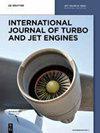Supersonic jet mixing in the presence of two annular co-flow streams
IF 0.9
4区 工程技术
Q4 ENGINEERING, AEROSPACE
引用次数: 0
Abstract
Abstract The mixing characteristics of a Mach 1.9 jet at three levels of overexpansion, corresponding to nozzle pressure ratio (NPR) 3, 4 and 5, in the presence of a sonic co-flow (secondary flow), which was submerged in a subsonic co-flow (tertiary flow) was studied experimentally. For these NPRs the secondary co-flow is sonic with underexpanded levels and the tertiary flow Mach number was found to be 0.41, 0.71 and 0.85, respectively. The centerline decay results of the primary jet show that the jet mixing is abated by the co-flow, at all levels of expansion. However, in spite of the reduced mixing encountered by the supersonic primary jet, the waves in the jet core are found to be weaker in the presence of co-flows. This may be regarded as an advantage from the shock associated noise point of view, in accordance with Tam’s theory; which states weaker the waves in the core, the lesser is the shock associated noise. The results show that the reduced mixing environment caused by the sonic co-flow alone leads to the jet core elongation of about 20%, 23% and 49%, at NPRs 3, 4 and 5, respectively. The core length of the jet is found to increase by 29%, 46% and 62%, respectively, at NPRs 3, 4 and 5, when both sonic and subsonic co-flow streams are present.两个环形共流存在下的超音速射流混合
实验研究了淹没在亚音速共流(三次流)中的音速共流(二次流)存在时,1.9马赫射流在喷嘴压力比(NPR)为3、4和5的三个过膨胀水平下的混合特性。对于这些核反应堆,二次共流是音速的,具有欠膨胀水平,三次流马赫数分别为0.41、0.71和0.85。初级射流的中心线衰减结果表明,在膨胀的各个水平上,共流都减弱了射流的混合。然而,尽管超音速初级射流遇到的混合减少了,但在共流的存在下,射流核心中的波被发现更弱。根据Tam的理论,从与冲击相关的噪声的角度来看,这可能被视为一种优势;哪个州的震波越弱,震波相关的噪音就越小。结果表明,在NPRs 3、4和5处,仅由声速共流引起的混合环境降低可使射流芯延伸率分别提高约20%、23%和49%。当声速和亚音速共流同时存在时,在NPRs 3、4和5处,射流的核心长度分别增加了29%、46%和62%。
本文章由计算机程序翻译,如有差异,请以英文原文为准。
求助全文
约1分钟内获得全文
求助全文
来源期刊

International Journal of Turbo & Jet-Engines
工程技术-工程:宇航
CiteScore
1.90
自引率
11.10%
发文量
36
审稿时长
6 months
期刊介绍:
The Main aim and scope of this Journal is to help improve each separate components R&D and superimpose separated results to get integrated systems by striving to reach the overall advanced design and benefits by integrating: (a) Physics, Aero, and Stealth Thermodynamics in simulations by flying unmanned or manned prototypes supported by integrated Computer Simulations based on: (b) Component R&D of: (i) Turbo and Jet-Engines, (ii) Airframe, (iii) Helmet-Aiming-Systems and Ammunition based on: (c) Anticipated New Programs Missions based on (d) IMPROVED RELIABILITY, DURABILITY, ECONOMICS, TACTICS, STRATEGIES and EDUCATION in both the civil and military domains of Turbo and Jet Engines.
The International Journal of Turbo & Jet Engines is devoted to cutting edge research in theory and design of propagation of jet aircraft. It serves as an international publication organ for new ideas, insights and results from industry and academic research on thermodynamics, combustion, behavior of related materials at high temperatures, turbine and engine design, thrust vectoring and flight control as well as energy and environmental issues.
 求助内容:
求助内容: 应助结果提醒方式:
应助结果提醒方式:


